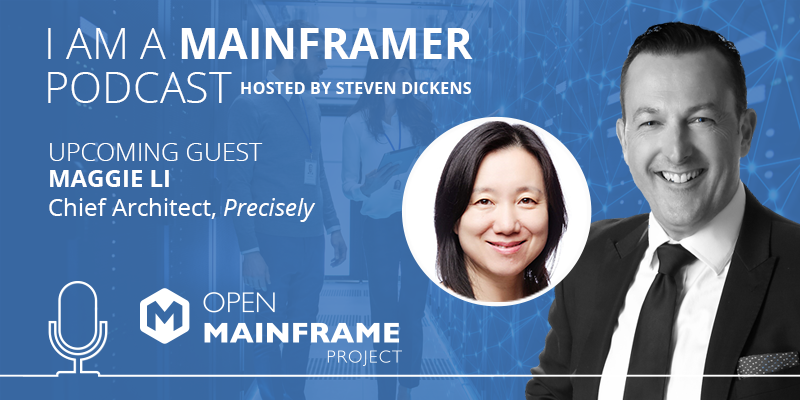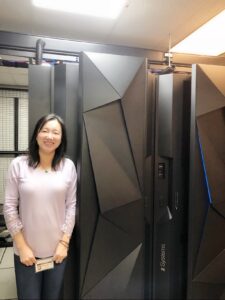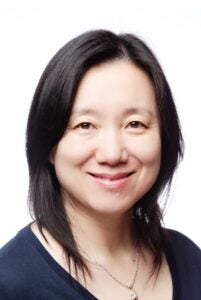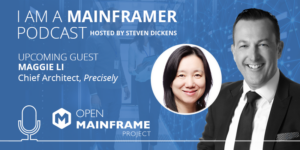
In today’s episode of the “I Am A Mainframer” podcast, Steven Dickens sits down with Maggie Li, Chief Architect at Precisely. On this podcast, Maggie discusses her journey with the mainframe, the challenges for the mainframe, Zowe, and where she sees the Mainframe going in the future.
Steven Dickens: Hello and welcome. My name’s Steven Dickens, and I’m the host of the I’m A Mainframer podcast, brought to you by the Linux Foundation. The Open Mainframe Project is a Linux Foundation collaborative project focused on promoting and advocating for Linux and Open Source on the mainframe platform.
I’m joined today by my guest, Maggie Li, who is the Chief Architect to Precisely, formerly of Syncsort. Welcome to the show. Maggie.
Maggie Li: Thank you, Steve. Thank you for having me.
Steven Dickens: So it’s great to chat. From what I can tell from your profile here, we’re going to have a good conversation today, and I think this is going to be a fun show for the listeners.
What I always ask our guests to do first is really just to give us an overview of how you got started, and how you ended up on the mainframe platform. So if you could just give us a brief overview, that’d be fantastic.
Maggie Li: Sure. I majored in electrical engineering in college, back in China. I guess I was one of the few girls who would choose engineering as a major back then. The school I went to is a well-known engineering school that had a male to female ratio of seven to one.
Steven Dickens: We’re going to come back and talk about that. We’re going to come back and talk about that, Maggie. That’s interesting, but carry on.
 Maggie Li: Okay, sure. After I graduated from college, I started my career as a home appliance engineer. I designed hardware and wrote assembly code in microprocessors to control microwaves, air conditioners, and other home appliances.
Maggie Li: Okay, sure. After I graduated from college, I started my career as a home appliance engineer. I designed hardware and wrote assembly code in microprocessors to control microwaves, air conditioners, and other home appliances.
It was kind of fun because I got to do a lot of cooking as part of my job. I remember we cook the chicken, beef, and vegetables to test the microwave recipes, and we eventually converted the recipes to code. That went for four years until I came to the US for postgraduate education. My major was electrical engineering again, with a focus on Telecomm.
The fact that I went to Syncsort after graduation was actually a surprise to many people. I got several job offers at the time. Among them, the most attractive one was from Motorola. So it sounded like a no-brainer, right? I almost accepted the offer, but changing my mind at the last minute. Because I really liked the people who interviewed me at Syncsort, and I thought it was a great culture fit.
Back then. I knew virtually nothing about mainframes, but I thought my assembly background may somewhat help and make my job easier. That’s why I came to the mainframe world.
I guess I was right about the people and the culture, but I was wrong about the job being easy. I did expect complexity, but I was not prepared for that level of complexity. I think you know what I mean.
Steven Dickens: I do. I do.
Maggie Li: Yeah, yeah. So, in the beginning, there was a lot of frustration. But luckily, I was surrounded by many supportive colleagues. With their help, I was able to get some traction and started to learn quickly.
After a few years of working on mainframes, I started to enjoy the challenge. And I can tell you I love the mainframe.
Steven Dickens: Oh, that’s good to hear. That’s good. So you’re on the right train.
I interrupted you because I was keen to kind of drill into the point. You mentioned a seven to one ratio there when you were an undergraduate. Can you maybe just kind of expand a little on that point? We’ve had a lot of really powerful female leaders on the show in the mainframe space, and I’m always keen for some of our younger listeners to hear about that journey.
So if you can maybe just expand on that topic a little bit, that’d be interesting. And talk about kind of how you’ve seen that progress since you were in college, through to where you are today as a really senior technical leader in Syncsort.
 Maggie Li: Okay. Sure. I loved math. I loved physics when I was very young. And my mother was a professor when I was in high school, and she always encouraged me to pursue my interests. So that’s why I started to learn electrical engineering for my major.
Maggie Li: Okay. Sure. I loved math. I loved physics when I was very young. And my mother was a professor when I was in high school, and she always encouraged me to pursue my interests. So that’s why I started to learn electrical engineering for my major.
But I would like to say to the girls that, if they think about their choice for their careers, I think it’s a good time for women in tech right now. I encourage them to give a try. Because of my own experience, I never felt gender has anything to do with one’s capabilities, even in the most hardcore technology areas.
For example, Precisely, there is something we have always been proud of. Our team had about 30% women, and over 40% of the leadership team was women. What’s interesting is we never had any quotas. This happened all naturally. And that says something.
So I would like to… My advice to other women in the industry is, you are every bit as capable as men in what you do, and your success solely depends on the number of efforts you put in. Be positive. Be proactive. Volunteer for more responsibilities if something aligns with your interests. And for the leaders, be mentors to other women.
I think if the girls can pick the technology industry, I think this is a great industry to work in. I believe in the foreseeable future; IT will continue to be a leading industry that will make most of the changes in people’s lives. Therefore we will see tremendous growth.
Steven Dickens: So it’s interesting, the journey you’ve been on, and how you’ve seen the challenges for representation sort of change. When I was reading your bio here, I picked up that you’re involved in the Master the Mainframe contest and how you mentor a group of high school students through that sort of contest to bring new fresh blood into the mainframe.
Have you seen any of those challenges or any of those concerns come through in your mentorship as you’ve moved towards the more senior part of your career? Have you seen anything there, Maggie, that you’d share with the listeners?
Maggie Li: So I feel the biggest challenge for the mainframe going forward right now is the shortage of skilled people. Because it has been there and will continue to be the biggest challenge for the mainframe, that’s my feeling.
Today it is extremely difficult to find professionals that are skilled in mainframe because the talent pool is quickly shrinking. Many people working on the mainframe are approaching their retirement age. But at the same time, we don’t get much new blood joining the workforce.
If we don’t do anything to turn this trend around, we will be in a very awkward situation when the existing talents do retire. That’s why I have personally tried to promote the mainframe to young people whenever I got a chance.
And I do love the Master Mainframe contest. I feel that the program is a great way to bring awareness of technology to people. And I hope it can stimulate some interest and help bring new talents into the mainframe world.
Fortunately, at Precisely, we have been fortunate in attracting young talent to the team. A team that will one day become the next generation of mainframe engineers at the company.
Steven Dickens: I agree. I’m a huge fan of the Master the Mainframe. I’ve had the pleasure of meeting some of the winners over the years at various events.
I’m always heartened by how those winners are sort of looking into embarking on a career with just unbounded optimism. And it’s infectious when you get to meet some of those younger mainframers as they embark on their journey on the platform.
Maggie Li: Yeah, the program was a fantastic program, and the winners could get t-shirts, gift cards, and backpacks. The kids were so happy. I could feel that.
Steven Dickens: So, Maggie, again, I was really impressed when I looked through the bio that the team sent through to me. Could you tell us a little bit about what you do specifically for Precisely as a chief architect?
I see some wonderful projects here, but it’s probably best for our listeners if you can give us a brief overview of what you’re involved in and what cool projects you’re working on.
Maggie Li: Sure. Just a little bit background of our company before I talk about myself. Precisely is a company with a 50-year history of delivering data-sorting and data-integration solutions for the IBM mainframe before last year’s Pitney Bowes software and data acquisition. Now we are the global leader for data integrity.
I have been with Precisely for 21 years. I started with the company as an assembly developer for mainframe sort products and MFX. Syncsort MFX was the core product back then.
Over the years, I went from developer to various management roles and was leading a number of R&D projects for MFX and our log data integration product, Ironstream. Both MFX and Ironstream are the main products for the company.
About three and a half years ago. I transitioned from the management trackback to a technology role, a technical role. My current role is Chief Architect for the mainframe portfolio. Most of what I do now is research new mainframe technologies and prototyping code for our mainframe products.
I am responsible for the architecture of Precisely Syncsort mainframe products family as well as the Ironstream product family. I also lead a cross-product architecture team in researching and reporting on a variety of topics across either portfolio of products.
So that’s what I do at Precisely.
Steven Dickens: I’m interested Maggie, you’ve obviously got a 21-year history on the platform. How have you seen things change over that 21 year period? The mainframes are a very different beast than it was back in the late ’90s. So I’d be really keen to get your perspective on what you’ve seen change over the years.
Maggie Li: The old days when I started from Syncsort, we used3270. And now recently we see mainframe and Linux and cloud getting closer and closer. In the future, I feel the mainframe will coexist with the distributed world and the cloud world.
This is why I have been working so hard in the past few years in our product called Ironstream. The old days, mainframe used to be the lack of accessibility of its data, I feel. So breaking data silos, that’s our focus at Precisely.
For example, Ironstream provides seamless integration of mainframe data with distributed and cloud-based systems. This way, our customers can monitor all their systems whether the systems are mainframe or distributed architecture from the same platform, the modern platform.
Mainframe customers run mission-critical workloads in the largest company around the world. One of our key strengths is the ability to connect mainframe data to modern readily-adapted platforms, such as Splunk, Kafka, and ServiceNow.
The other things I’m thinking it will be in the future, we will have the same or similar DevOps tools and user experience in the mainframe as in the distributed and the cloud system. I’m thinking in the future; our users do not need to develop two sets of skills to code their business applications. The end-users will not be able to tell from the user interface, whether the underlying system is a distributed system in the cloud or a mainframe in the cloud.
This is the Open Mainframe Project, IBM, and CA, I feel we are working hard on this effort. And I really appreciate that.
Steven Dickens: Yeah. That’s an interesting area. We’ve got a strong community built around the Zowe Project. And I think you were hinting at some of that in your previous answer. How do you see that as part of a future for the mainframe?
Maggie Li: We are looking at Zowe, too. We feel modernizing our mainframe products with cloud user experience will help our customers reduce their development time. So we started to evaluate different options, including OpenShift and Zowe.
we need to pick the right solution for different products. Participating in Zowe Conformance Program is one of our options.
Actually, we joined the Open Mainframe Project last year. we trusted the Linux Foundation. Linux Foundation is a community we trust. Our company joined the ODPi project five ago, and we have been working with the Linux Foundation very closely since then. And later, we joined Hyperledger Project, and last year, we joined Open Mainframe Project.
Steven Dickens: So, Maggie, I think you’ve given us a really good overview there of some of the big trends and things you’ve seen. I’m always keen to understand maybe what you would have said to yourself back in ’99. What advice, if you could have a time machine, what advice would you go back and give to your younger self as you were just starting to embark on this career?
I always find the answers to this are interesting for our listeners who are maybe thinking about how they’d start their career. So what advice would you have given to your younger self?
Maggie Li: I think if I could go back, I would choose the mainframe again. Because mainframe actuality has a lot of architectural advantages, maybe a lot of people didn’t know like security, speed, and availability.
Security is very important, right? It has been a growing concern in recent years as we see more and more frequent data breaches. The most shocking one to me was the Equifax instance that happened in 2017.
Every time something like this happens, it impacts millions of people and could cause losses in billions of dollars. And to me, I feel the mainframe is the most secure machine even right now. I will not say the mainframe system is invisible, but we are much less vulnerable than a distributed system.
So I will see the mainframe will survive in another 20 years with cloud, Linux, and every modern technology, every modern platform. Also, availability and reliability is another key advantage.
I’m not sure if you know, the Z in [inaudible 00:20:40] brand name, it means zero downtime. And they are guaranteed to run continuously for 40 years without any failure. I got that from the internet, and that’s amazing.
Steven Dickens: Yes. Some of the stats are just… I remember a client presenting to a big audience saying that they’d not had a second of planned or unplanned outages in over 20 years. So I think that stat kind of blew me away. [crosstalk 00:21:13]
Maggie Li: Yes. So for many organizations, the value of this advantage is far greater than the cost of the system. So this is probably why they have been staying with the mainframe. And this is why I love the mainframe. And I would like to choose the mainframe industry again if I could go back.
Steven Dickens: So as we look to wrap up here, Maggie, I always ask our guests on the show, if you could look ahead into a crystal ball, where would you see the mainframe, sort of three to five years from now? What are those big trends that are going to impact the mainframe platform over that period of time?
Maggie Li: Like what I said, in the future, I feel this, every mainframer and Open Mainframe Project, hard work. In the future, I would expect the end-user will not be able to tell from the user interface, whether the underlying system is a distributed system in the cloud or a mainframe in the cloud.
Steven Dickens: Yeah. I think I see the same trend in our future. So it’s really interesting that you share that perspective.
Maggie, the time has flown by. This has been a fantastic conversation. I think our listeners are going to be really interested to understand a little bit about your personal journey. So thank you for sharing that with us today.
Maggie Li: Thank you.
Steven Dickens: Are there any other parting comments or anything else you want to share before we wrap?
Maggie Li: Nothing else. Thank you very much, Steve.
Steven Dickens: No, and thank you from the listeners and from me. It’s been great having you on the show.
So you’ve been listening to the I Am A Mainframer podcast. I’m your host, Steven Dickens. It’s been great listening to Maggie talk to us today from Syncsort.
If you’ve liked what you’ve heard on the show, please click below and give us a rating and help us promote Linux and open source on the mainframe platform.
I’ll sign off and I’ll speak to you next time.
